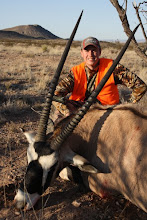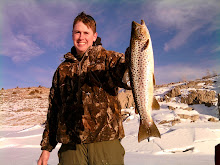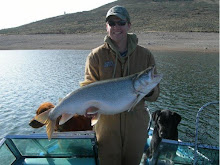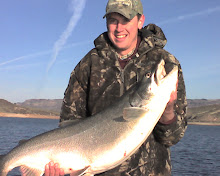Check out my article in last weeks Gunnison Times!!
For many of us, the hunting season has come to a close or is almost done for the year. The hiking and biking trails are starting to turn white and our train of thought has turned to winter. It’s time to sharpen the skates, wax the skies and ready our fishing gear for the hard water. Or is it? Before we peel the braided line off our reels and traded the long rods in for short ones, maybe the lake is worth one more look.
Many anglers have already hung their hats up for open water season of 2010, but might be missing out on some of the best action of the year. In late fall, the water has cleared up after the large bodies of water have finished turning over and the fish are becoming active. Why? Well as many anglers know, the spring fishing right after ice out is perhaps some of the best fishing all year. This is due the large amount of oxygen in the shallower parts of big bodies of water which attracts fish.
It is not uncommon to hear spring fisherman talk about the lake heating up and the fish slowing down. This is because as the water heats up, it loses oxygen content and the fish move deeper to find water that is more oxygen rich not just to breath easier, but because their pray is following the same oxygen levels also. So what does this have to do with fall fishing? The fall turnover has the exact opposite effect of the spring turnover. The lake turns over because of changes in the water temperature. As the water cools in the fall, it pushes downward and forces the warmer water on the bottom to rise, bringing the contents up with it. This is where the mossy green water comes from and the fishy smell that is associated with it.
This mixing action of the water “folds” in large amounts of oxygen and allows the fish to again rise from the depths and come into striking distance of the angler. When the water clears enough for fish to regain good visibility is when fall fishing heats up. The brown trout are able to prowl the rocky shorelines looking for food and the rainbow trout can move onto the sandbars where food is more abundant.
To co-inside with the fall turnover is the lake trout’s annual spawn. The mackinaw move into shallower water to lay and fertilize their eggs. Until lake trout spawn, they are relatively inactive and feeding is held to a minimum. However, unlike the kokanee salmon, lake trout do not die after the spawn and start feeding heavily. Much like a bear puts on weight before winter, so does a lake trout. The last couple weeks before the lake freezes and into the first part of ice fishing, fish are very actively trying to increase their body weight to help with the oncoming winter. It is often overlooked that fish are cold blooded animals which means they stay relatively the same temperature as the water they live in. Slight water temperature changes have big effects on fish and their movements. As the water gets colder throughout the winter, their feeding slows along with their body temperature. The water becomes more dense and absorbing the oxygen from it becomes more cumbersome. Thus a fish’s movement continually slow until right before the thaw when the water moving in from the rivers and streams start to warm.
Fishing during the few weeks prior to ice on puts an angler in position to catch fish during some of their most active feeding times all year long. While each body of water will have slight timing differences due to things like altitude, depth and size, the trend will remain the same for each lake based on one thing, water temperature. Before changing to ice fishing gear, think about another trip to the big Blue or Taylor Reservoir. You might catch that fish you’ve been looking for all season.
On a side note, if you plan to fish from a boat, remember that the boat ramp hours have shortend for the off season. Before pulling your boat out of storage, make a quick call to make sure you will be able to get on and off the water with your schedule. Also, make sure to drain all the water from your boat with freezing temperatures everynight! Good luck and remember keeping your tips up doesn’t just apply to skiers.
Thursday, November 18, 2010
Tuesday, April 20, 2010
Fishing line is just fishing line, Right???
Wrong! How long has it been since you have examined the line selection at your local sporting goods or super store? It seems like choosing a line has become worse then picking toilet paper. An entire isle of practically the same thing that will all get the job done, some just might not be nearly as effective. Before we even start, keep in mind that you should be changing your line AT LEAST annually. Fishing line can and will get very brittle and even high pound test will break with just your hands or tying on a lure, even if it has only been used a couple of times. I have seen several fish, including one this last weekend, not only break off, but steal a lure expensive enough to have paid for new line.
So, the first thing to consider is the species of fish you will be fishing for. Keep in mind that the smaller the diameter the easier it will cast. Basically you want the smallest diameter that will still avoid 99% of break offs. I would recommend for trout to start in the 6-8lb test range. Lake trout and Pike will require a heavier line, something in the 12-20lb test range should suffice. Pan fish will only require a 4 or 6 lb test. Now lets talk about different kinds of line. Monofilament is your standard fishing line that granddaddy and dad have been using for years. It is usually the cheapest but still has its place. Mono is still the clearest colored line and is my favorite for super clear water. However, mono is more prone to abrasion so check the last 24" of your line after every fish and re-tie if needed. Mono also stretches so a harder hook set is needed and often is not sensitive enough to fill the bottom with certain techniques like jigging.
The new braided lines are more expensive but are more abrasion resistant. They come in several colors which can be helpful in different water conditions: but one color is not right for every water color which requires more line changing than mono. My favorite is green and I use it in a couple water colors but usually not clear. I prefer braided line for toothier critters as well, because I can get away without a steal leader most of the time. Some of the newer lines also offer a heavier pound test at a small pound test diameter. This is especially helpful when doing a lot of casting. For example my pike set up has a 12lb test braided line which carries a 6lb diameter for casting rocky shore lines. Even with braided line, it is important to check the last 24" of line for nicks and re-tie when you find one or more. Whatever you decided, the cost of a spool of line is something that can easily cover itself in cost, and there is nothing worse than taking a friend or favorite nephew fishing only to have them break several fish off and lose your favorite two lures in the process. So get out there, fishing season in the Rocky Mountains is here. Good luck, cast straight, and set the hook like a monster is on the end.
So, the first thing to consider is the species of fish you will be fishing for. Keep in mind that the smaller the diameter the easier it will cast. Basically you want the smallest diameter that will still avoid 99% of break offs. I would recommend for trout to start in the 6-8lb test range. Lake trout and Pike will require a heavier line, something in the 12-20lb test range should suffice. Pan fish will only require a 4 or 6 lb test. Now lets talk about different kinds of line. Monofilament is your standard fishing line that granddaddy and dad have been using for years. It is usually the cheapest but still has its place. Mono is still the clearest colored line and is my favorite for super clear water. However, mono is more prone to abrasion so check the last 24" of your line after every fish and re-tie if needed. Mono also stretches so a harder hook set is needed and often is not sensitive enough to fill the bottom with certain techniques like jigging.
The new braided lines are more expensive but are more abrasion resistant. They come in several colors which can be helpful in different water conditions: but one color is not right for every water color which requires more line changing than mono. My favorite is green and I use it in a couple water colors but usually not clear. I prefer braided line for toothier critters as well, because I can get away without a steal leader most of the time. Some of the newer lines also offer a heavier pound test at a small pound test diameter. This is especially helpful when doing a lot of casting. For example my pike set up has a 12lb test braided line which carries a 6lb diameter for casting rocky shore lines. Even with braided line, it is important to check the last 24" of line for nicks and re-tie when you find one or more. Whatever you decided, the cost of a spool of line is something that can easily cover itself in cost, and there is nothing worse than taking a friend or favorite nephew fishing only to have them break several fish off and lose your favorite two lures in the process. So get out there, fishing season in the Rocky Mountains is here. Good luck, cast straight, and set the hook like a monster is on the end.
Tuesday, April 6, 2010
Lake Trout I can hear you calling my name!
While these windy days of spring are miserable to work in, they sure help thaw out the lake in a hurry. This means one thing, BIG lake trout in shallow water. I have heard two different reasons why the laker's move shallow in the spring and the fall. One theory I have heard is that the lake trout really like a certain level of oxygen in the water which is constant at a certain temperature, the other is that the bait fish that lake trout eat like a certain temperature of water. Either way, their movement is directly related to temperature. As the lake warms up they will move shallower and shallower until a certain point when they reverse and start moving deeper. During the month after and before ice out, the fish will move all the way to 10' of water or less. When the surface temp hits 50-55 degrees magic starts to happen. Even though these fish are shallow, they will not be caught all over the lake. The old saying, 90% of the fish live in 10% of the water still holds true. The nice thing about big lake trout is they are very predictable and the places they are caught is consistent from year to year. In fact the last two state records where caught within a few yards of each other but two years apart. And don't be afraid to use big bait. It's not uncommon for people to catch fish on 10"-12" whole suckers or 3oz jigs. The best part is, as soon as the fishing on blue mesa starts to slow, Taylor is just getting started. There is really 2 good months of lake trout fishing between the two lakes. So get your rods and reels out of the closet, it's fishin time!
Tuesday, March 2, 2010
Colorado Draw is getting close!
You know the saying, if it's not hunting season, it's application season! Okay, maybe I'm the only one who says it, but it is true. Whether you have never applied in Colorado or are a seasoned pro, don't forget to check out the proclamation this year. Colorado runs on a 5 year season structure and this is year one of five, so there are some big changes. Look for some new early season elk hunts this year. A couple of these will take great hunts and make them unbelievable. These have become the best elk hunts in the state over night. For those of you holding onto a pile of deer points, you might want to hold on them if you have been looking at the Gunnison basin. We are still recovering from the big winter a couple years ago. However, a couple mild winters in a row have gotten us on the right track to recovery. A couple more years and will should be right back to the good ol days of passing up 160" bucks. However, if you are the guy who is just starting or only have a couple points you might consider Gunnison. A lot of people are waiting for the deer to make a full recovery, and while there isn't the deer there was a couple years ago, they didn't all disappear and you just might sneak a Boone'r in with little or no points. Don't over look the north west corner of the state either as it continues to produce some whoppers. If you have some money to loan the DOW for a couple of months apply for Sheep, Goat, and or Moose. While you have to front the tag fees, the application fee's are next to neil and you will get almost all of your money back along with a preference point. Don't forget antelope either. A lot of big bucks roam the prairie of Colorado but a lot of them take a mountain of points to hunt so start accumulating now. If you have any questions are have never applied in Colorado, check out our website (www.weekendwarrioroutdoors.com) and see what we can do to help.
Thursday, February 25, 2010
African Safari in New Mexico?
I recently took what some would consider the hunt of a lifetime. I could not argue though I hope to have several "hunts of a lifetime" but this one will no doubt make the list. For those of you that didn't know, in the 1960's New Mexico transplanted some exotic species to the southern part of the state including Gemmsbuck (oryx), Ibex, and Barbary Sheep (Aoudad). All of these animals can now be hunted and are free ranging. That's right, exotic hunts that are not high fence hunts! The tags are hard to come by, but sure worth looking at applying for. I was fortunate enough to draw a February Oryx tag on the Stallion section of the White Sands Missile Range. What a blast!! 55 degree weather in mid winter, plenty of animals and something different than anything I've ever done. If you have never looked at these hunts you need too. The unfortunate thing is that until this year, you only had to submit a $12 application fee to apply. Starting this year all tag fees in New Mexico must be fronted. The upside is the odds should get a lot better, but the downside, obviously, is having to front some serious coin. For those of you thinking about checking out these oryx hunts, don't forget the application period is sooner than the rest of the critters in New Mexico. In fact, the application deadline has already come and gone for this year, Feb 3rd. These hunts are a little different than your conventional hunt in that there is 70 tags given out and they are two day, once in a lifetime hunts, but sure is worth a look if you are interested in experiencing a little bit of Africa just a few miles down the road. Don't let the tag numbers or short season detere you. Most hunts run 70%-80% success rates. Based on my hunt, use your optics and you will see plenty of animals. Get out of your truck and you will lose 80% of the crowd. If you have any questions or would like me to fill out applications for you, check out our website www.weekendwarrioroutdoors.com . Good luck and happy hunting!
How deep do I fish when Ice Fishing?
Probably one of the most common questions I get about Ice fishing is how deep do I fish and where in the water column are the fish? The answer? It depends. Not trying to be a smart alic, but place and depth is different for different species of fish. In general, 90% of the fish I pull through the ice come off the bottom. In fact I often try to bounce my jig off the bottom. As a general rule, stay no more than two reels off the bottom. The exceptions are rainbow's and kokanee.
Kokanee: are almost never on the bottom, in fact the hardest part of finding kokanee is finding the depth. Once you catch one, you can usually catch more by keeping your lure at the same depth. Look to start at 40' of water and move deeper fishing the whole water column as you move.
Rainbows: In my experience the biggest rainbows come from or near the bottom but it is not uncommon to find the fish traveling in suspended water. You may be missing out by not trying different depths. While rainbow's can come from deeper water I would focus on 10-20'
Browns: Browns almost always stay on the bottom. I like to spend 90% of my brown fishing time one crank off the bottom. If you miss a fish, quickly check your bait and put it right back down. More often than not you will get another chance at that fish. More important than depth is structure. Look for rock points and ridge lines that might extend into the water.
Lake Trout: Keep your bait right on the bottom. In fact I like to let my jig rest completely on the bottom for a few seconds every now and then. The jigging motion needs to be slower and a lot more deliberate. Keep in mind that some of the softest bites turn into the biggest fish. The biggest fish I have ever caught through the ice hit so soft that it barely moved the line across the hole with absolutely no downward pressure. Look for flatter spots often in front of bays and coves. Start around 30' and work out up to 60' or more.
The biggest problem unsuccessful fishermen have is being stationary. If the fish aren't biting, MOVE. It is not uncommon for me to move 3, 4, 5 times in the course of a morning. Even if it is only a few yards. Sometimes even a small move will take you out of moss, over a rock pile, out of a rock pile, etc. Even with a hand auger, what does it matter how long it takes to drill a hole if you aren't catching anything anyways. So, drill some holes, have some fun, and enjoy a fresh fish dinner tonight. Ice fishing can be some of the most productive fishing and we still have a few weeks of great fishing left.
Kokanee: are almost never on the bottom, in fact the hardest part of finding kokanee is finding the depth. Once you catch one, you can usually catch more by keeping your lure at the same depth. Look to start at 40' of water and move deeper fishing the whole water column as you move.
Rainbows: In my experience the biggest rainbows come from or near the bottom but it is not uncommon to find the fish traveling in suspended water. You may be missing out by not trying different depths. While rainbow's can come from deeper water I would focus on 10-20'
Browns: Browns almost always stay on the bottom. I like to spend 90% of my brown fishing time one crank off the bottom. If you miss a fish, quickly check your bait and put it right back down. More often than not you will get another chance at that fish. More important than depth is structure. Look for rock points and ridge lines that might extend into the water.
Lake Trout: Keep your bait right on the bottom. In fact I like to let my jig rest completely on the bottom for a few seconds every now and then. The jigging motion needs to be slower and a lot more deliberate. Keep in mind that some of the softest bites turn into the biggest fish. The biggest fish I have ever caught through the ice hit so soft that it barely moved the line across the hole with absolutely no downward pressure. Look for flatter spots often in front of bays and coves. Start around 30' and work out up to 60' or more.
The biggest problem unsuccessful fishermen have is being stationary. If the fish aren't biting, MOVE. It is not uncommon for me to move 3, 4, 5 times in the course of a morning. Even if it is only a few yards. Sometimes even a small move will take you out of moss, over a rock pile, out of a rock pile, etc. Even with a hand auger, what does it matter how long it takes to drill a hole if you aren't catching anything anyways. So, drill some holes, have some fun, and enjoy a fresh fish dinner tonight. Ice fishing can be some of the most productive fishing and we still have a few weeks of great fishing left.
Labels:
blue mesa,
brown trout,
fishing,
ice fishing,
lake trout
Subscribe to:
Posts (Atom)




